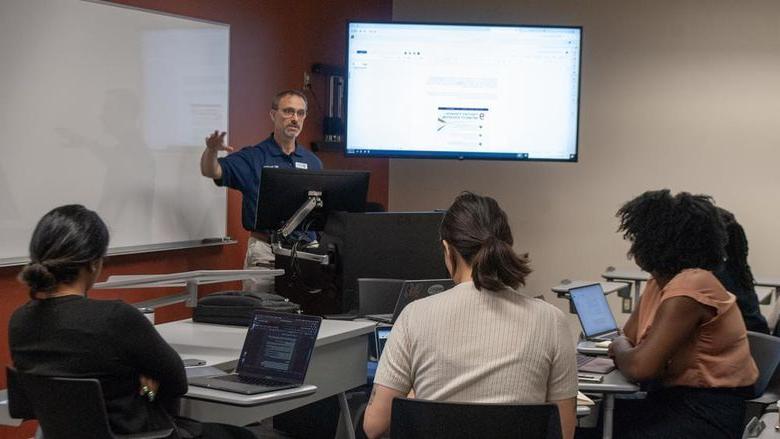
第二阶段的战略规划过程将持续到秋季学期.
返回结果
-
机构计划草案的初步建议正在提交社区审查, with feedback being collected throughout the fall semester.
-
强烈鼓励所有社区成员在strategicplan上提供反馈.事业单位.edu.
-
University leadership hopes to receive insights from every unit, college and campus through the website and in-person engagements.
-
单位级规划的指导和资源将在秋季学期晚些时候共享, with unit work expected to begin in the spring.
UNIVERSITY PARK, Pa. -JDB电子的机构战略计划草案已经公布,并与社区分享反馈和讨论. All 教师, 工作人员 and 学生s at all campuses are encouraged to visit the strategic plan website to review and provide feedback on the draft plans for four goal areas.
“我要感谢JDB电子的许多人,他们已经在这个过程的第一阶段和第二阶段贡献并分享了他们的专业知识. As we move forward, 我认为这个社区反馈阶段是战略规划中最关键的部分,” said Penn State President Neeli Bendapudi. “如果我们要成功地制定一项战略计划,推动JDB电子社区从伟大走向伟大, we need your perspectives.”
整个夏天, 专门的工作组制定了目标、指标、指标和战略草案在经过校董会的初步审查后,这些报告正在被分享.
“该草案旨在捕捉我们认为对推动大学更接近我们的目标至关重要的内容, 但是你的声音和意见对于我们是否已经确定了关键因素在这个阶段是至关重要的,大卫R说。. 史密斯, associate dean for advising, 本科学部执行主任兼第二阶段学生成功工作小组成员. “我们可行的战略计划需要得到我们社区中每天从事这项工作的人的验证.”
To learn more about each goal area and to share feedback, visit:
Each goal has a streamlined framework, including objectives (what we want to achieve), metrics (how we will measure success), and strategies (how we will move the needle, outlined in the community surveys).
该计划草案旨在关注关键领域,以帮助激励JDB电子社区并衡量实际影响. The institutional plan is not intended to be an exhaustive reflection on every priority; rather, 这个以社区为主导的计划的愿景是确定该机构可以实现的进步,并易于理解, adopted and actionable.
额外的 目标
“通过学术和临床协同改变医疗保健”的目标将遵循JDB电子卫生和医学院领导的独特时间表和过程. 在草案完成后,将要求社区对此目标提供反馈.
除了, 每个战略计划目标都将得到“内部运营转型”目标和其他大学计划的支持,为实现JDB电子的目标提供必要的基础设施和支持.
“Instead of pursuing its own trajectory, we will deeply embed ‘Transforming Internal Operations’ into each goal of the plan, 我们将继续确保我们的运营具有支持性和影响力,以帮助实现我们的愿景,” said Michael Wade 史密斯, senior vice president and chief of 工作人员.
How to provide feedback
Before the feedback window closes later in the fall semester, University leadership encourages every unit, 大学和校园通过网站和面对面的交流来提供他们的见解.
促进参与和利用那些在大学直接相关的每个计划的目标领域的专业知识, the Office of Planning, 评估和机构研究(OPAIR)将继续领导有针对性的合作, working sessions and gatherings throughout the fall. 单位, 希望在头脑风暴讨论期间提供反馈的团体和委员会应联系 (电子邮件保护) to schedule those engagements.
通过网站提供观点的社区成员将被要求与大学员工分享他们的联系, 教师, 学生, 校友, 等.)及其单位. While not required, 鼓励个人分享他们的名字,以便OPAIR跟进任何问题.
“When we say, ‘We are,’ it is a phrase that elicits a sense of community. 我们的社区建立归属感的一种方式是通过一个强有力的战略计划,” said Boni Fernandes Wozolek, 宾州州立大学阿宾顿分校包容性卓越项目主任兼教育学副教授 a member of the Phase 2 DEIB goal working group. “With this in mind, I hope that we receive strong, 建设性的反馈,这样我们就可以从宾州州立大学社区的声音中获取想法.”
Once the feedback forms close, 社区成员的反馈将被分析并用于修改计划草案. 大学领导层希望在早春之前与社区分享最终的机构计划.
Phase 3: Unit-level planning
As the institutional planning process continues, guidance and resources for unit-level plans will be shared later this fall. 各单位将制定各自的计划,包括支持机构的战略 目标, objectives and metrics during the spring, with assistance from OPAIR.
“Our institutional plan will serve as the North Star for each unit, aligning all our efforts with key University priorities, 同时也使我们的个人社区能够规划自己独特的成功之路,” said Tracy Langkilde, interim executive vice president and provost. ”在一起, these efforts will not only fortify our University-wide plan, but also provide ambitious and actionable frameworks for each unit.”
随着战略规划过程在整个秋季学期及以后形成, the Penn State community is encouraged to visit strategicplan.事业单位.edu regularly for updates and opportunities to engage.





